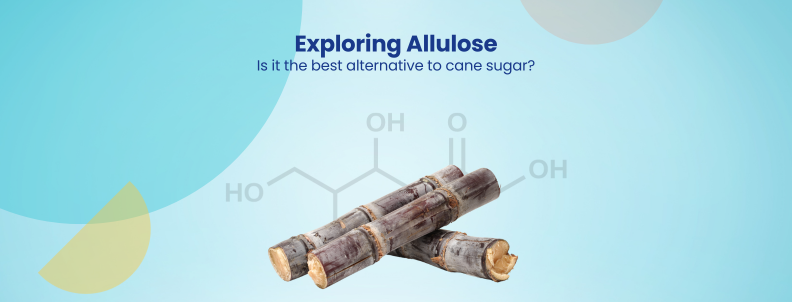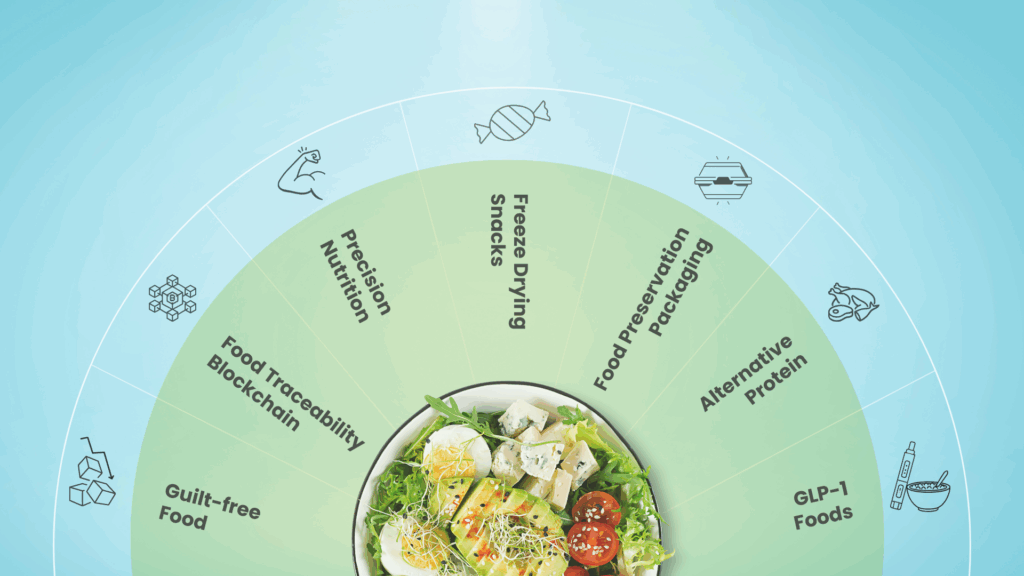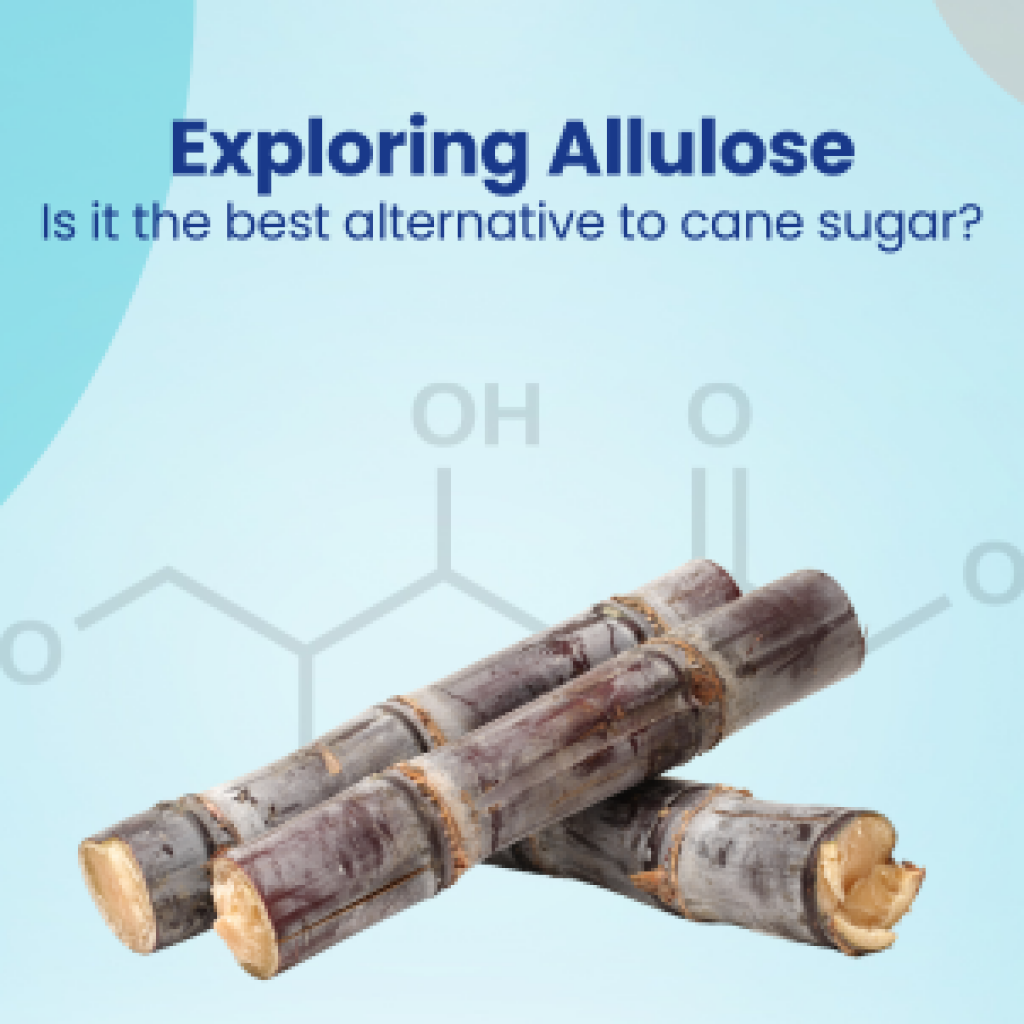Researchers have found a way to produce high-purity allulose using microbes! This new method requires minimal maintenance and can be scarce for mass production. In addition, industry giants like ASR Group and Hershey’s are investing in startups that can commercialize allulose.
The market demand for the artificial sweetener Allulose is rising. It is predicted to grow from $236.9 million in 2023 to $543.2 million by 2033.
The rising demand is catalyzed mainly by the heightened consumer awareness of diabetes, obesity, and heart diseases linked to sugar consumption. But is allulose the best choice as a natural sweetener and alternative to cane sugar? Let’s analyze.
GreyB’s full report discusses how Allulose can become a commercialized sweetener and replace sugar, the innovators in this area, and potential roadblocks to foresee. Fill out the form below to access the comprehensive guide on Sugar Reduction Solutions.
Important Allulose Facts at-a-glance
| Physical forms | Powder, Liquid, Crystal |
| Market application | Food, Bakery and Confectionery, Dairy and Frozen Desserts, Sauces and Dressings, Beverages |
| Regions of operability | North America (U.S., Mexico), Asia-Pacific (China, Japan, India, South Korea, Singapore, Remaining Asia-Pacific regions), LAMEA (Brazil, Saudi Arabia, United Arab Emirates, South Africa, Remaining Latin American regions) |
| Key Market Players | Tate & Lyle PLC, Quest Nutrition, CJ Cheiljedang Corp., McNeil Nutritionals, Bonumose LLC, Cargill, Apura Ingredients, Anderson Global Group, Ingredion Incorporated, and Matsutani Chemical Industry Co. Ltd. |
Patent Activity from various Allulose innovators
Given Allulose’s benefits, an increase in research and patent activity for this sugar alternative is unsurprising. Massive brands like Samyang Corporation have been selling liquid allulose since 2017, starting as the brand “Trusweet,” and are supplying it to beverage, ice cream, and dairy companies in Korea.
Another company, CJ Cheiljedang, has been working on Allulose for quite some time now and has launched products such as AllSweet™ Allulose Low-Calorie Sugar.
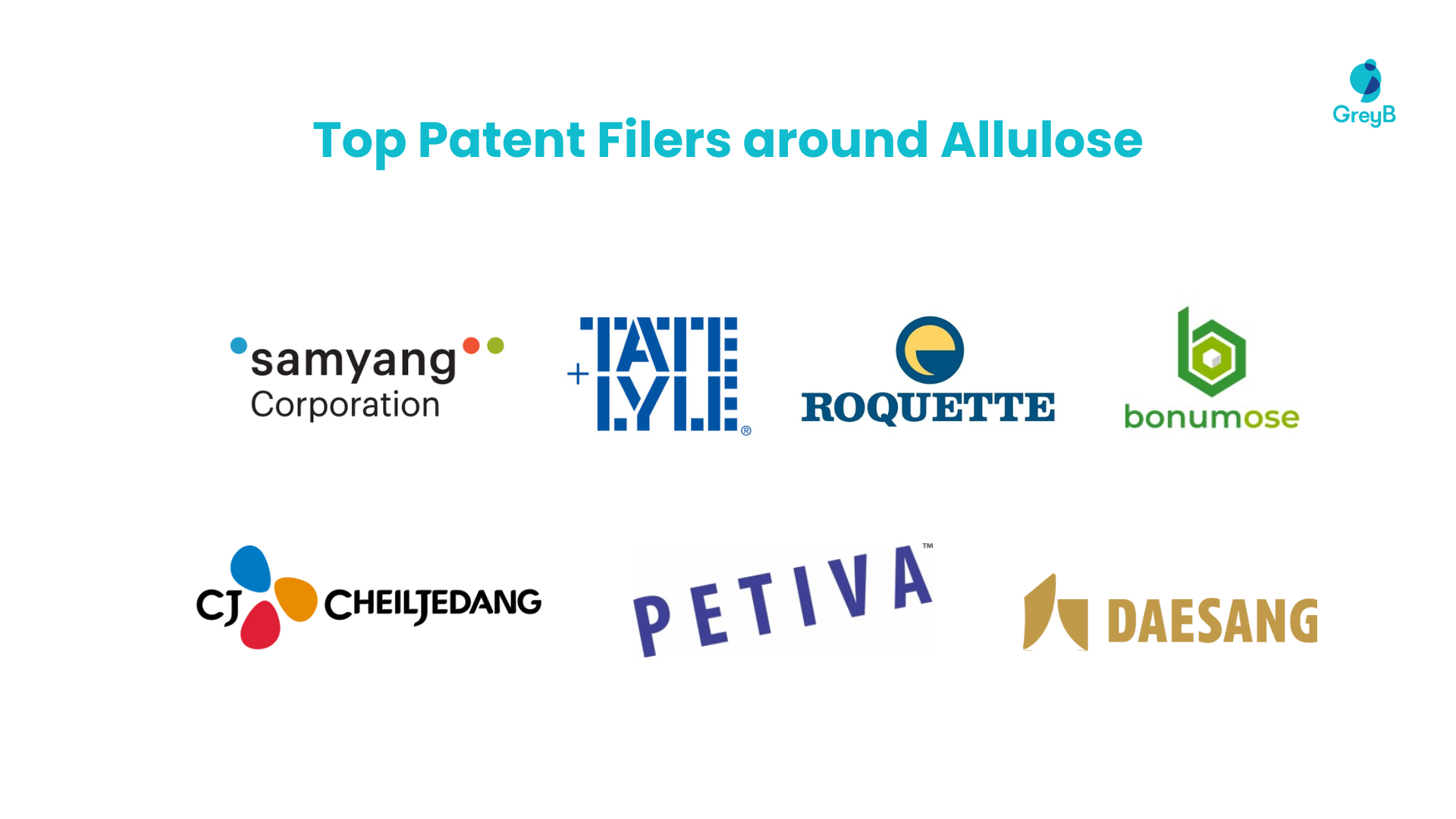
Patenting activity in allulose and dairy products has increased exponentially since 2014-15. The level of patenting activity increased by approximately 1.5 times, whereas new product development in food and beverages utilizing allulose increased by 45%.
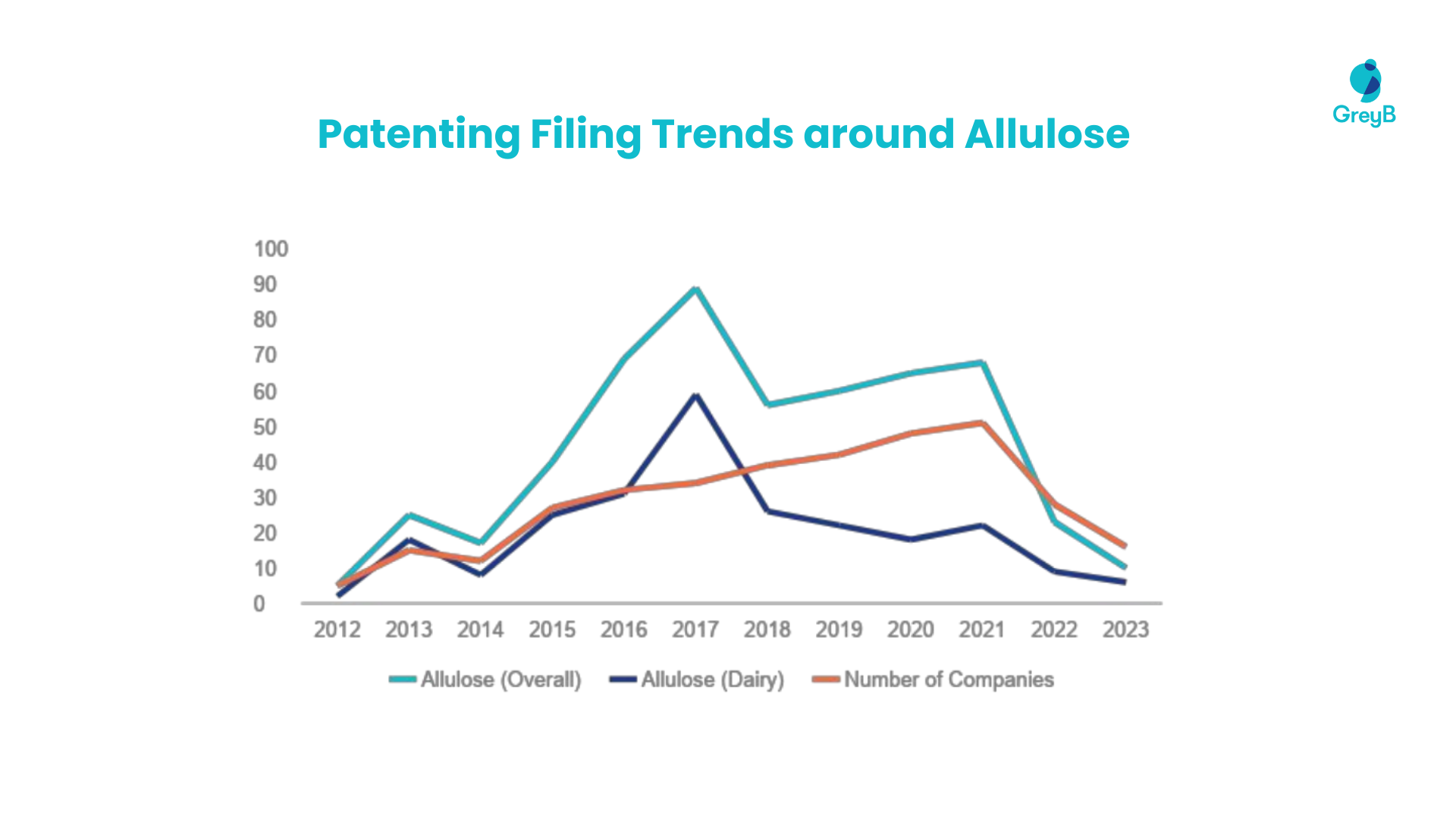
Interestingly, the number of companies filing allulose patents rose from 2015 to 2017, but it has remained fairly stagnant. Please note that the complete data after 2022 isn’t available to analyze yet.
Breakthrough Innovations in Allulose as Sugar Alternative
UC Davis & Mars Advanced Research Institute
In collaboration with the Mars Advanced Research Institute, Professor Shota Atsumi from the UC Davis Department of Chemistry has discovered a new way to use microbes to produce allulose.
The researchers developed a method for producing high-yield and high-purity allulose through precise fermentation by activating a natural process in a microorganism. They found an industrial microorganism with the enzymes to make allulose and edited the organism’s metabolism to get the cells to convert glucose into allulose.
The cells consume all the glucose they are fed and convert it to allulose with a noteworthy concentration, a yield of over 60%, and a purity of over 95%, outperforming the existing production methods.
This new method is efficient, economically feasible, and could be scaled up for commercial production. The new approach has a more than 99% theoretical yield with high purity and only requires minimal processing to isolate the desired product. This discovery could help address one of the primary obstacles to the widespread adoption of these alternatives- their production costs.
Bonumose
Bonumose, a Virginia-based startup, has patented a cost-effective technology enabling mass-market adoption of rare sugars like allulose. In early 2022, Bonumose raised a Series B round led by Hershey and sugar refining giant ASR Group to support the commercial production of its sugar alternative sweeteners, allulose and tagatose.
These innovations can significantly enhance the affordability and accessibility of allulose, making it a more viable sugar substitute for the mass market.
Advantages of using Allulose as a sugar alternative
Identical taste to cane sugar
Unlike stevia, monk fruit, and erythritol, Allulose is chemically similar to table sugar. So, they have almost the same taste profile.
Usable in bulk
Allulose is about 70% as sweet as sugar, meaning more would be needed to substitute for sugar. So, it adds bulk and texture.
1/10th caloric intake
One critical property of Allulose is its caloric value. It’s just 0.4 calories per gram, which is one-tenth of the calories in sugar.
Diabetes-friendly
In conducting studies for the GRAS process, researchers found that Allulose, a non-nutritive sweetener, does not impact blood glucose and suppresses the glycemic response (potential to raise blood glucose) of other glycemic carbohydrates when tested with carbohydrates. When tested as an individual ingredient, Allulose is shown to be non-glycemic.
Promotes Weight Loss
UC Davis conducted a study involving 100 overweight adults randomly assigned to receive an allulose or a sucrose (table sugar) diet. The participants followed their assigned diets for 12 weeks. Ultimately, the allulose diet participants had significantly less weight gain than those who received sucrose. The allulose group also had significantly less body fat gain and a more significant decrease in fat percentage. The researchers concluded allulose is a beneficial alternative to sucrose for weight loss.
Freezes and Bakes like sugar
Like sugar, allulose depresses the freezing point of frozen products. It also has excellent solubility, so it can be easily used in frozen dairy products. It also has similar browning properties to sugar, making it usable for baked goods.
Shortcomings and Challenges of Using Allulose Sweetener
Since allulose is a relatively new sweetener, some concerns exist about its short-term and long-term effects on the body. If consumed in significant quantities, allulose can cause stomach discomfort, including gassiness, bloating, and nausea. But that’s true of most other artificial sweeteners, too.
In addition to the side effect concerns, there’s the regulatory side. Currently, allulose is not approved for use in Canada & Europe. Under Health Canada’s Food and Drug Regulations, this sweetener is regarded as a novel food ingredient since it has a limited history in food. Novel foods must undergo a pre-market safety assessment before being sold in Canada.
In Europe, allulose is also classified as a ‘novel food.’ This means it needs authorization from the European and the UK Food Safety Authorities to trade in these markets. It is currently being reviewed and is awaiting the EFSA green light.
It is also worth noting that the FDA has classified allulose as ‘Generally Recognized as Safe’ (GRAS). They categorized it as a general-purpose sweetener for foods and beverages where sugar (or fructose) would typically be used.
Furthermore, allulose manufacturers must submit scientific evidence of safety, including publicly available research, with the notification for FDA’s review.
Cosun Beet Co., Ingredion, Matsutani Chemical Industry, and Samyang Corp. have announced a new consortium called Allulose Novel Food Consortium (ANFC) to speed up the regulation approvals. This consortium will help bring allulose to the EU and UK markets and support its nutritional labeling as a carbohydrate.
Conclusion
Allulose is a promising alternative to cane sugar as a food sweetener. Despite its regulatory challenges and ambiguous health implications, research is going strong in this domain to make it more mainstream.
If you have a specific question, please submit it using the form below. Our experts will contact you soon!
Authored By – Gaurav Sahni, Intelligence Team
Edited By – Hemanth Shenoy, Marketing

